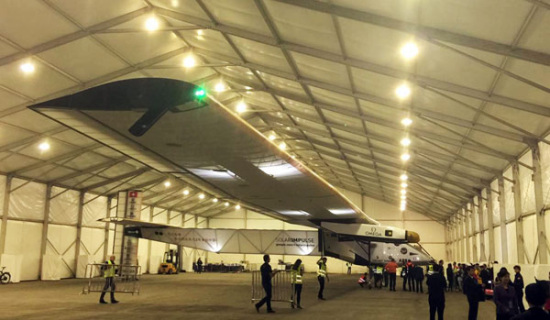
Solar Impulse 2, the first solar-powered aircraft capable of flying day and night, lands in Chongqing, China, on March 31. (Photo: Tan Yingzi/China Daily)
Solar Impulse 2 landed in Chongqing, China, on Tuesday, the fifth-leg of the Swiss-developed airplane's quest to become the first aircraft to fly around the world powered only by the sun.
The plane took off from Mandalay, Myanmar's second-largest city, on Monday afternoon for Chongqing, where it will stay for a couple of days due to weather conditions and then fly to Nanjing. During its stopover in Chongqing, the two-man crew and members from the Swiss embassy to China will visit a local middle school.
Solar Impulse is the first solar-powered aircraft capable of flying day and night. It is made of carbon fiber and has 17,248 solar cells built into its wing that supply the plane with renewable energy.
Bertrand Piccard was the pilot for the Myanmar to Chongqing flight. Piccard said it is "a privilege" to bring the first solar-powered plane to Chongqing. "It's amazing for us; it's an honor to be here," he said.
Piccard said that he hoped that the plane's arrival would raise the public awareness of clean energy in China. "We will make a lot of friends here and they will follow us around the world," he said.
After 22 hours in the air, Piccard said he was not tired but full of passion for piloting the plane.
Picard's co-pilot, the former Swiss fighter pilot André Borschberg, will fly the plane from Chongqing to Nanjing, and then the pair will cross the Pacific Ocean to the United States.
They will take turns piloting the single seater for 21,748 miles (35,000km) over 12 legs, including across the Atlantic and Pacific oceans. The entire journey back to Abu Dhabi, where the plane took off from on March 9, will take five months and include stops in India and the United States.
The pilots will fly roughly 250 hours each inside a narrow cockpit with no oxygen or temperature control. Temperatures outside will range between 40C to 40C. Both pilots will take 20-minute naps every two to four hours. They will practice yoga to deal with the physical discomfort of remaining confined to a seat for so many days at a time.
Piccard, who is a psychiatrist as well as being part of the team that in 1999 first circumnavigated the globe non-stop by balloon, has taught himself and Borschberg techniques of self-hypnosis and meditation to maintain concentration.
















































